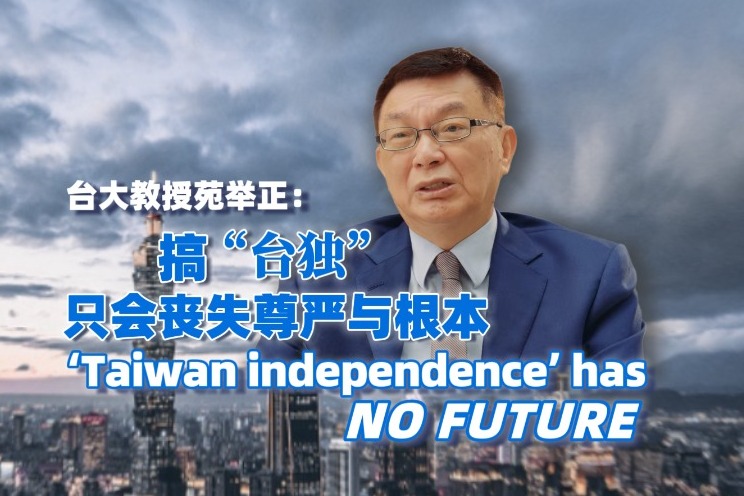Emerging industries take fresh growth path
New quality productive forces spur rise in output triggered by tech innovation


At a logistics port in Shenzhen, Guangdong province, a ship laden with domestically manufactured new energy vehicles, or NEVs, is set to sail for distant shores.
On Feb 8, a new route to South America was launched, with Chinese-made NEVs embarking on an overseas journey.
Amid a global economic downturn, China's development of the "new trio" — electric passenger cars, lithium-ion batteries, and solar cells — has won global recognition.
Last year, the cumulative export value of the "new trio" surpassed 1 trillion yuan ($139 billion) for the first time, representing a 29.9 percent rise from the previous year, the General Administration of Customs reported. This growth rate solidified China's position as the world leader in terms of NEV manufacturing and solar energy installed capacity.
Technological advancement, key to the development of such emerging industries, is becoming a focus of attention for the Chinese government and companies. Together, they expect technological evolvement to constitute a new form of productive forces, inject fresh impetus for economic growth in the country, and boost its global competitiveness.
"New quality productive forces", a concept coined recently in China, refers to advanced productivity that breaks free from traditional economic growth modes and productivity development paths to feature high-level technology, efficiency, and quality.
Shen Minggao, chief economist at GF Securities, said new quality productive forces signify a leap in productivity driven by technological innovation — distinguishing themselves from traditional production methods that rely on extensive resource input and high energy consumption. This departure from a conventional growth path is in line with the requirements for high-quality development to emerge as an innovative force in the digital era.
Charlie Zheng, chief economist at Samoyed Cloud Technology Group, said: "We find ourselves at the onset of a transformative technological era, primarily propelled by artificial intelligence and digital technology. The swift adoption of these innovations by businesses is expected to lead to a rapid surge in productivity, encapsulating the essence of new quality productivity."
In December, the Central Economic Work Conference called for efforts to promote industrial innovation through sci-tech innovation and, in particular, develop new industries with innovative and cutting-edge technologies to foster new quality productive forces.
Since the central government sharpened its focus on the development of such productive forces, local government departments have been quick to respond.
Take Guangdong for example. On Feb 18, the first working day after Spring Festival, the province, which has been the nation's leader in total economic output for 35 consecutive years, convened a high-quality development conference.
Huang Kunming, Party secretary of Guangdong, emphasized the need to unwaveringly pursue the path of high-quality development with a focus on technological innovation. He said the concept of "new quality productive forces" provides clearer guidance and an effective means for steering high-quality development.
Guangdong is witnessing positive momentum in advancing new quality productive forces, Huang said.
Several noteworthy accomplishments include the successful development of the AG600 amphibious aircraft, which is designed to carry out critical rescue missions, DJI drones, which are renowned globally, and advances in areas such as quantum communication, commercial space exploration, and the low-altitude economy.
The latter is an economic concept that relies on low-altitude airspace, with the general aviation sector playing a dominant role.
Deep-sea scientific exploration is also progressing rapidly in Guangdong, along with sectors such as the internet, big data, cloud computing, blockchain and AI. Huang said sustained efforts will be made to harness technology to transform existing productivity and establish new quality productive forces.
Strengthened government attention has sparked a series of reactions on the stock market, with stocks related to the concept of "new quality productive forces" witnessing robust momentum.
Shanghai Kelai Mechatronics Engineering Co saw an 11-day consecutive limit-up by Feb 24. Limitup is the maximum amount a price is permitted to rise during one trading day.
Several leading companies in niche sectors characterized by high-tech, such as Saimo Technology Co, also touched limit-up in the past week.
Focal point
Fostering new quality productive forces to support innovative development this year has become a focal point for businesses.
Chen Wei, president of chip manufacturer Guangzhou Can-Semi Technology, said the company will speed construction of its CanSemi Phase III project. It aims for a fixed asset investment of more than 4 billion yuan to ensure the project is completed and in operation this year.
Wang Chuanfu, chairman and president of carmaker BYD, said the company will use its core technological advantages to create more new quality productive forces and contribute to a more sufficient, resilient and stable supply chain.
"The electric vehicle industry is developing rapidly, and the intelligent vehicle sector is also accelerating its development. NEV development will only accelerate, giving us no opportunity to pause, slow down, or catch a breath," Wang said.
As forecast by global market research companies such as Counterpoint Research and many other institutions, in the fourth quarter of last year, BYD, the world's top seller of pure electric vehicles, sold 526,400 such vehicles, outpacing Tesla, which sold 484,500.
As BYD's sales surged, its financial performance followed suit. Its profit last year is estimated at 29 billion to 31 billion yuan, a year-on-year rise of 74.46 to 86.49 percent. In 2022, the company's profit surged by 445.9 percent year-on-year to 16.62 billion yuan.
Shi Jianhua, deputy secretary-general of EV industry think tank China EV100, said: "China's huge market potential and technological advances make it an important force driving the industry's development globally. Continuous tech breakthroughs will also give rise to new brands. It is anticipated that one or two more Chinese NEV brands will enter the global Top 10 list in terms of sales volume this year, boosting the share of Chinese firms to over 40 percent."
Latest predictions from China EV100 show that global NEV sales are expected to surpass 20 million this year. China is expected to make up 60 percent of the total, with sales value surpassing 2 trillion yuan. Moreover, output of NEV batteries and materials in China this year is likely to account for more than 50 percent of the global total.
"Rapid NEV development will continue to drive growth in sectors such as infrastructure, automotive parts, smart manufacturing, and intelligent automotive solutions — injecting impetus into China's economic growth," Shi said.
Fueled by technological advances, China's wind and solar power sector has also won global recognition.
The China Photovoltaic Industry Association, or CPIA, said the nation saw 163.88 gigawatts of new photovoltaic installations in the first 11 months of last year, marking a remarkable 149.4 percent year-on-year growth. Triple-digit percentage surges were witnessed in most months, with those in March topping 400 percent.
Wang Shijiang, CPIA secretary-general, said: "China's solar power global market share has exceeded 80 percent. Technological prowess is evident in continuous breakthroughs, such as achieving a 33.9 percent conversion efficiency in crystalline silicon-perovskite tandem solar cells, setting yet another world record."
The National Renewable Energy Laboratory's highest efficiency chart published on Dec 15 shows that Chinese entities held seven world records in the past year.
The highest efficiency record for silicon-based solar cells, which was again set by Longi Green Energy, stood at 27.09 percent on Dec 19, as certified by the Institute for Solar Energy Research in Hamelin, Germany.
The previous record of 26.81 percent was also set by Longi. The company broke another world record, with its 33.9 percent conversion efficiency for crystalline silicon-perovskite tandem solar cells in late November.
Jiang Dongyu, head of the distributed PV business at the company, said: "Solar cell technologies are evolving rapidly and Longi had been cautious in expanding production. In the past two years, the company has focused on developing technologies that support longer life span and differentiated performances for batteries."
Solar module maker Shanghai Aiko Solar Energy Co said it will continue to strengthen its research and development investment in new technologies used for making batteries and components.
The company launched its ABC (All Back Contact) module in 2022, with a conversion efficiency of 26.8 percent. The module is used in centralized power stations.
Chen Gang, chairman of Aiko Solar, said the company will develop groundbreaking technology, and relentlessly drive improvements in converting solar energy to electricity to produce green, renewable and cost-effective photovoltaic energy.
liuyukun@chinadaily.com.cn
- Diplomats visit important wartime sites
- Tianjin Port crew member rescues a Filipino seaman
- Govt asks medical bodies to submit procurement volume for bulk-buy program
- China's top court enhances handling of foreign-related cases
- Zhengzhou issues flood alert, orders closures amid heavy rainfall
- PLA releases footage of drones hunting 'hostile warship'





































